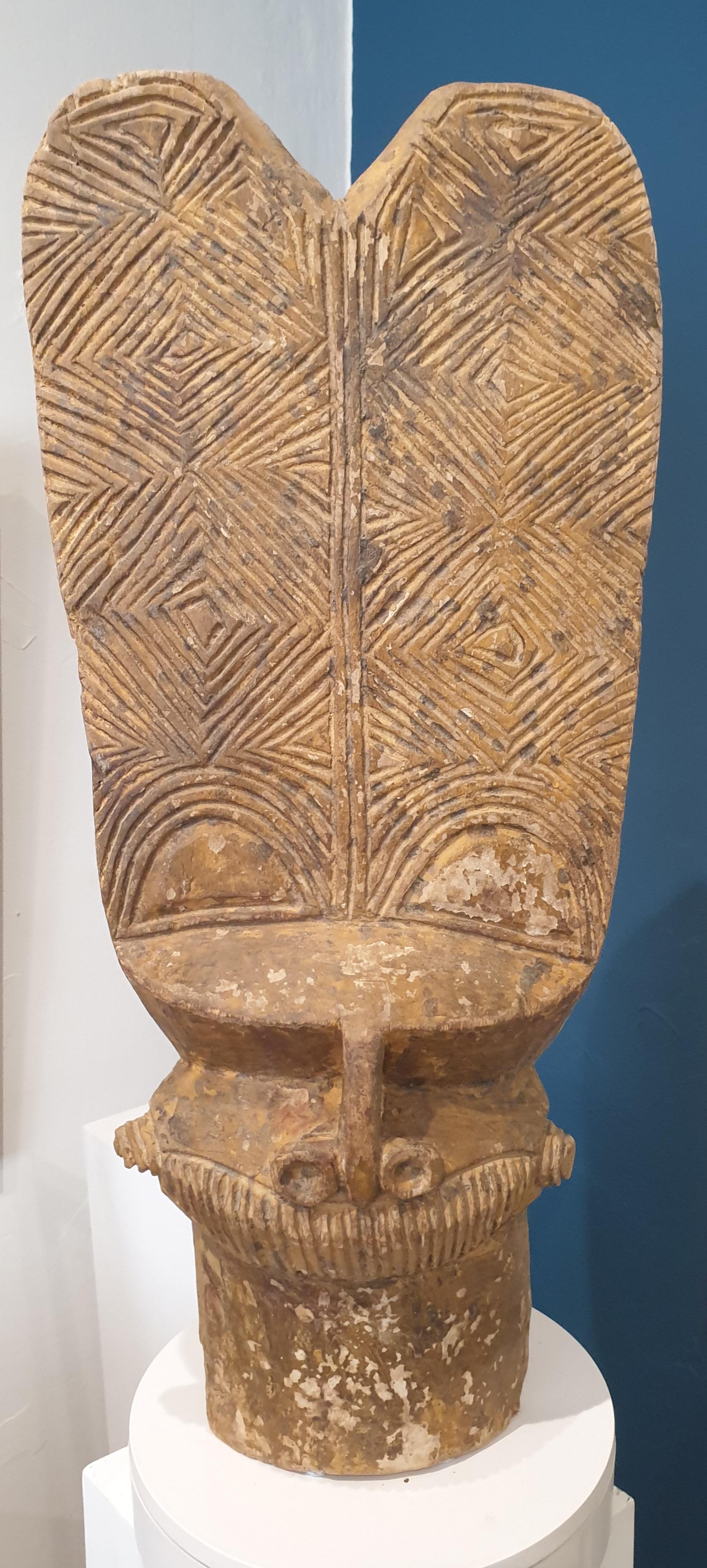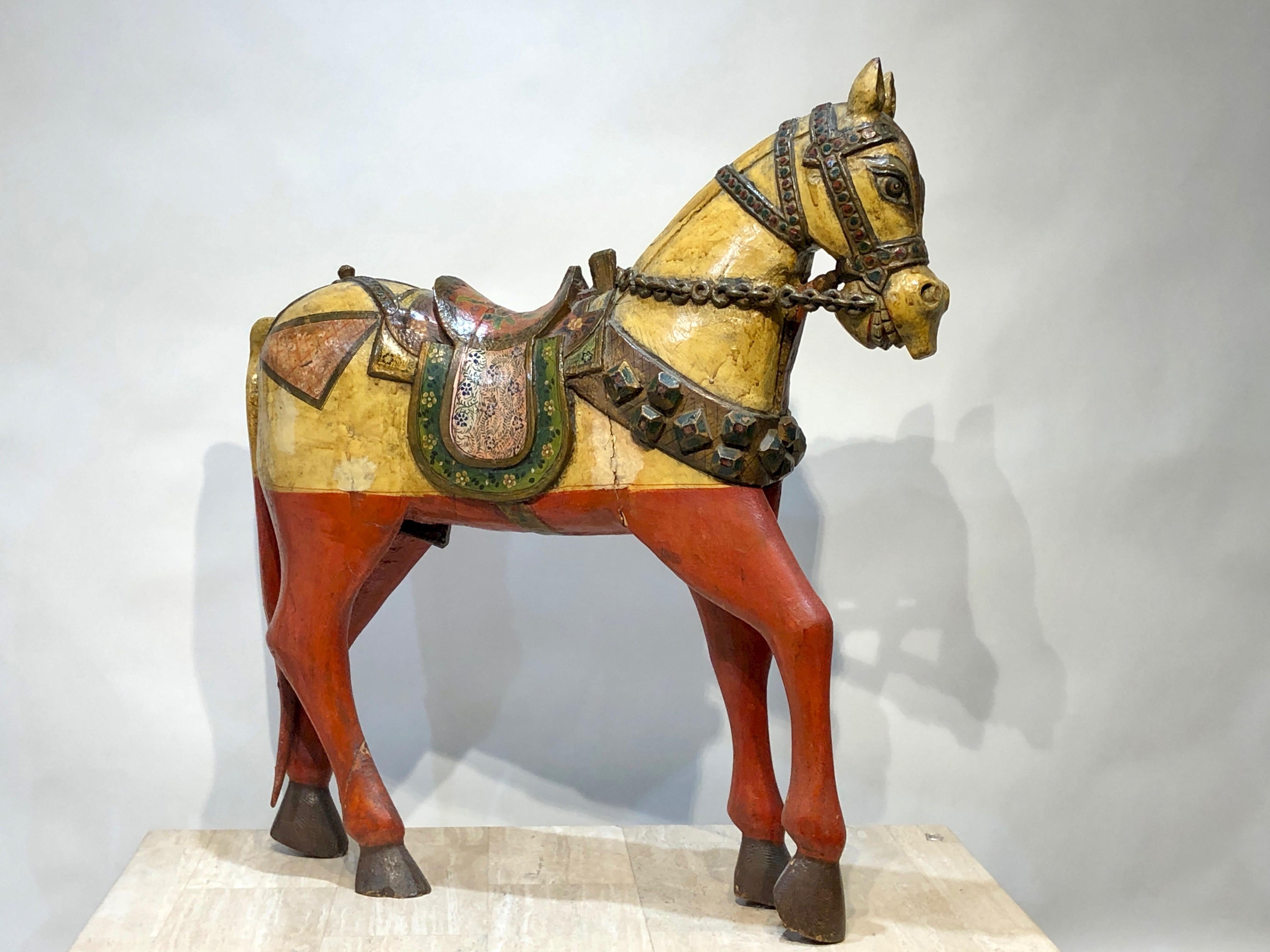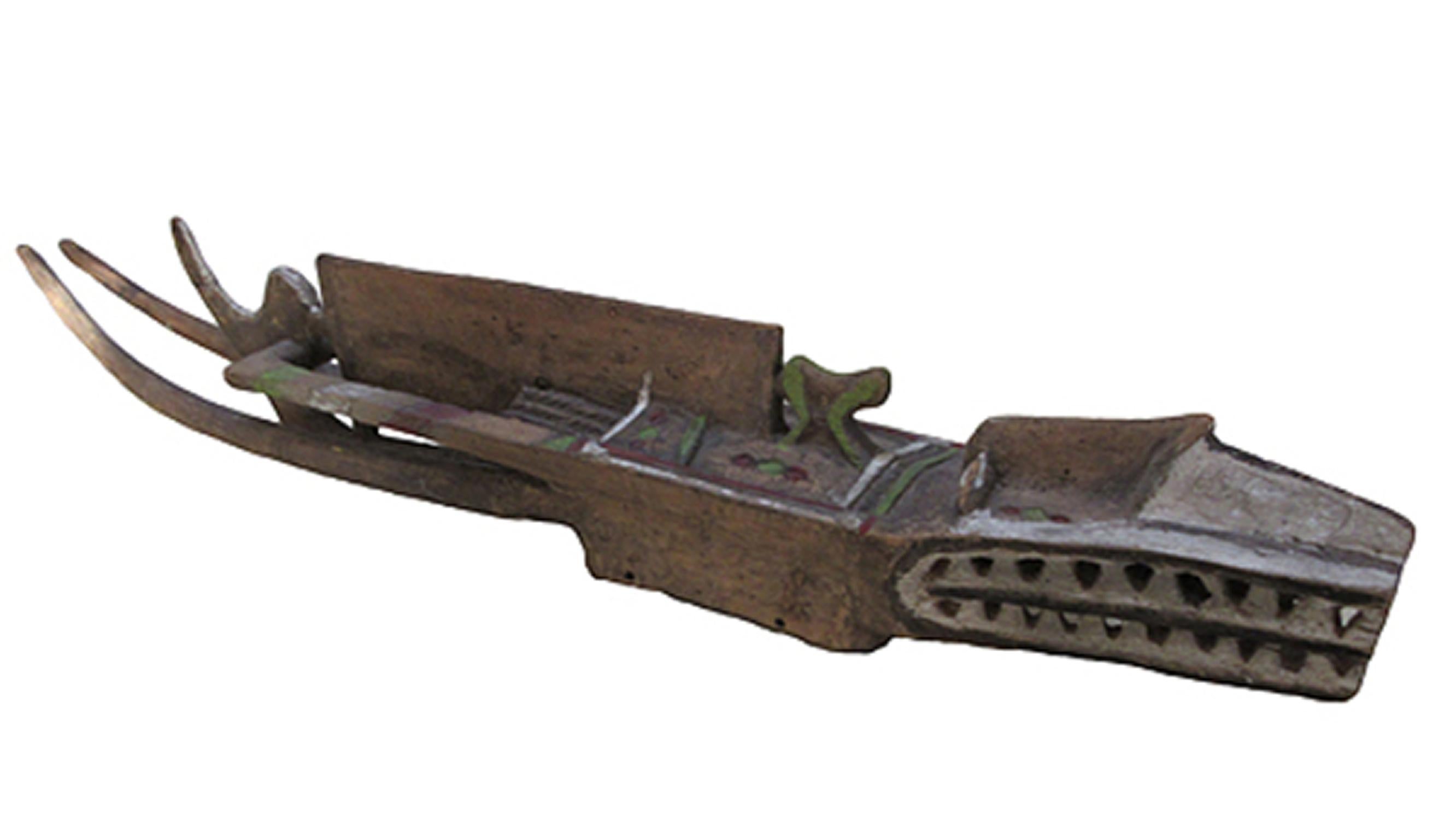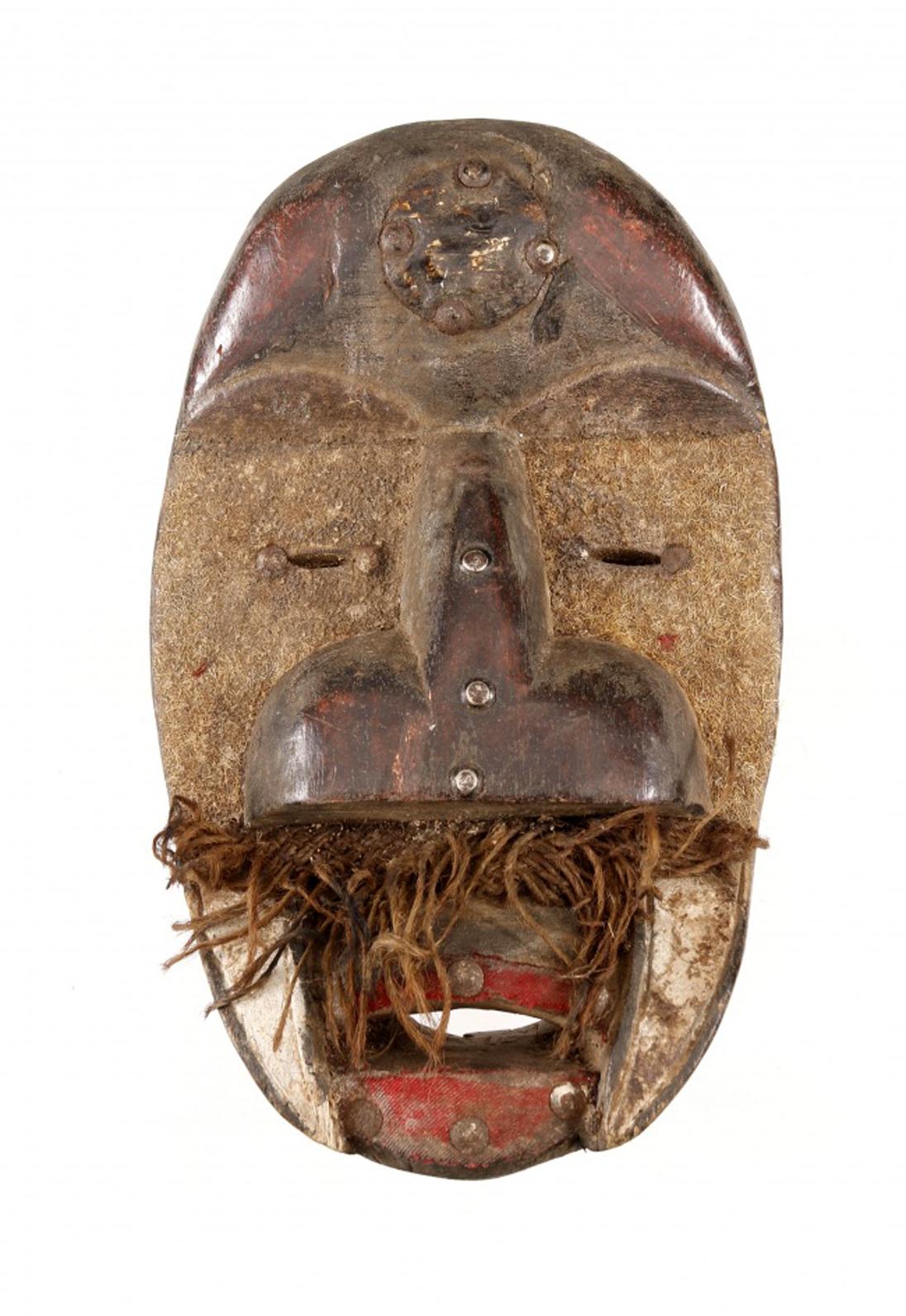Items Similar to African zoomorphic puppet head sculpture from the Bozo Tribe in Mali.
Want more images or videos?
Request additional images or videos from the seller
1 of 11
UnknownAfrican zoomorphic puppet head sculpture from the Bozo Tribe in Mali.Early 20th Century
Early 20th Century
About the Item
Early 20th century zoomorphic African puppet head sculpture from the Bozo tribe in Mali.
This puppet head would have been used by the Bozo ethnic group during the Sogobo ceremony.
This ancestral tradition continues in the region of Segou in Mali along the Niger river. It is an opportunity to regroup the different villages and give rise to musical and theatrical performances whose highlight is the puppet show.
Far from being profane, each sculpture is intended to honour the spirits of nature so that they protect the people and ensure the abundance of the rains, of fishing and harvesting.
Sogo bó, from sogo: Animal, meaning “the animal comes forth”.
It refers to the mask and puppet theatre that plays a key role in the culture of two peoples closely linked in central Mali: The
Bozos – the fishermen, and the Bamana – the farmers. These plays are a blend of numerous forms of theatrical expression:
Dancing, singing, music, puppets and masquerades (masked dances). In addition to performances governed by the farming season for the Bamanas, and the fishing season for the Bozos, puppet shows are put on to mark important community events: Marriages, circumcision ceremonies which take place every ten years and funeral rituals, etc. All the villagers, regardless of age or gender, can attend the shows, which take place on the village square and sometimes on
the river in the case of the Bozo community.
Once upon a time there were puppets :
The myth surrounding the creation of the puppets is handed down by way of tradition, from one generation to the next:
One day, Toboji Centa, a Bozo fisherman, was abducted by
the genies of the bush. One of them introduced him to the
art of puppetry. On returning to his village located on the
banks of the River Niger, Toboji Centa passed on his newfound
knowledge to his community and taught blacksmiths
and sculptors how to make puppets.
The history of Sogo bó dates back to the 14th c.: Ibn Battûta (1305-1377), a traveller from Tangiers who stayed at the Court of the Mali Empire in 1355, witnessed Sogo bó theatre, which he described as follows:
“... A pleasant approach whereby poets recite their lines
disguised as birds inside a costume of feathers topped by a
wooden head with a red beak” .
Who is hiding behind the puppets?
In some traditional African societies, puppetry is reserved for certain age brackets: In the case of the Bozos and the Bamanas, it is performed specifically by youth groups known as ton, which bring together young men of the same age bracket at puberty. Away from the village, the young people learn from their elders how to identify and manipulate each puppet. They are also taught about the history of puppetry and the symbolic values, songs and
rhythms associated with it. The women do not handle the puppets but play an active role in the performance by singing.
The ton steer the cultural principles of the community as well as rules governing lifestyle at a level where solidarity is of paramount importance.
Man and animals:
Items of the Bozo and Bamana theatres depict a crowd of figures based on both traditional animal-related beliefs and modern society:
The zoomorphic or animal puppets illustrate the symbolic relevance given to animals in the African imagination. Thus in the Bozo fishing communities, the river animals are everpresent: hippopotamus, crocodile, etc.
The anthropomorphous or human puppets represent all the social ranks within the community, from the village chief to the farmer and settler via mythical figures such as Faro, the goddess of water or even Yayoroba, the incarnation of the
feminine spiritual and physical ideal.
The head measures : 63cm tall from the base.
44cm from tip of wooden post to nose tip.
18cm from tip of ear to tip of ear.
Purchased from Pierre Robin ( the renowned Parisian collector of Bozo art ) in the 1970's.
- Creation Year:Early 20th Century
- Dimensions:Height: 24.81 in (63 cm)Width: 7.09 in (18 cm)Depth: 17.33 in (44 cm)
- Medium:
- Movement & Style:
- Period:
- Condition:
- Gallery Location:Cotignac, FR
- Reference Number:
About the Seller
5.0
Platinum Seller
These expertly vetted sellers are 1stDibs' most experienced sellers and are rated highest by our customers.
Established in 2000
1stDibs seller since 2020
146 sales on 1stDibs
Typical response time: <1 hour
- ShippingRetrieving quote...Ships From: Cotignac, France
- Return PolicyA return for this item may be initiated within 3 days of delivery.
More From This SellerView All
- Moi, Flags, Cats and Poppies, Very Large Scale Mixed Media 'Assemblage'By Armand AvrilLocated in Cotignac, FRImposing and very large scale mixed media 'assemblage' by French artist Armand Avril. The work includes the French tricolour flag, figures and heads in various poses, his symbolic cat sculptures and large stylised poppies. The work is not signed but comes with a certificate of authenticity from the artist. This montage fully demonstrates Avril's inspiration drawn from tribal art whilst also expressing the humour and joy that he puts into all his work. A very strong sculptural image and a feast for the eyes in searching for and recognising the everyday objects used in making this piece come alive. This montage is made from wood pieces, bottle tops, string, paint, cork, nails buttons, clothes pegs and netting. The more sculpted areas of the piece stand out up to 4cm from the frame. Armand Avril was born in 1926 in Lyon. His father, Marcel Avril was a painter and collector of African art. At 16 Armand became an apprentice shepherd in Provence. Avril could always be seen equipped with a sketchbook and a book on the history of art whilst tending his flock. It was not until the age of 30, in 1956, that Armand embarked on painting as an autodidact, influenced by Raoul Dufy, Pierre Bonnard, Henri Matisse and the Lyonnaise School of Painting. He exhibited for the first time in 1957. In 1960, he left for a one-year trip to Africa. There he met the painter Jean Arène who introduced him to the village of Cotignac in the Var and to Louis Pons...Category
Late 20th Century Tribal Mixed Media
MaterialsMetal
- A Large Scale, Beautifully Sculpted and Patinated Batcham Cameroon Mask.Located in Cotignac, FRA large scale and beautifully carved wooden ceremonial mask from Cameroon. There are traces of colour and decoration to the surface and the mask has a magnificent patina giving it a wonderful presence as a sculptural object. The Batcham Mask or simply the Batcham originated in western Cameroon although its name refers to the place where it was first found: Batcham. This is a ceremonial mask from the Bamileke culture in the western Grasslands of Cameroon. This tall crest (76 cm in height) has clearly defined features, a powerful yet calm visage, sharply chiselled diamond and triangular furrows, and nearly perfect symmetry. Such painstaking craftsmanship underscores the sophistication and control of the sculptor in preparing this ceremonial piece. It shares the elements of Batcham masks including: The general morphology is built on two axes: a symmetrical vertical axis with chiseled furrows, stylized eyes, lips, nostrils, mouth and teeth; a horizontal axis presenting swollen cheeks, an ovular mouth showing multiple teeth, and triangular ears supported on a hollow cylindrical base. One interpretation is that the masks depict a hippopotamus emerging from watery depths, conveying nature’s power conferred to enthroned royalty. The Batcham mask represents the pi, or double animal of a great dignitary of the kingdom. It was used by a great dignitary of the Msop society who intervened only on rare occasions: during the funeral and enthronement of the king and the nine notables, and to perform the Royal Tso dance, elephant dance...Category
20th Century Tribal Sculptures
MaterialsPaint, Plaster, Wood
- Statue Songye, Republic of Congo, Misangu Glass Beads & Chiefly Raffia SkirtLocated in Cotignac, FRA Songye Male Power Figure, Democratic Republic of the Congo, the male figure with openwork arms and hands resting on the abdomen, typical facial features and a waterbuck (kobus elli...Category
Mid-20th Century Tribal Figurative Sculptures
MaterialsMetal
- Statue Songye, Kneeling Male Figure, Democratic Republic of CongoLocated in Cotignac, FRA Songye Male Power Figure, Democratic Republic of the Congo, the male figure resting on one knee, with openwork arms and hands resting by the abdomen which contains various charms a...Category
Mid-20th Century Tribal Figurative Sculptures
MaterialsMetal
- Mid Century Sgraffito, Saltimbanque and the Card Player, Circle of Picasso.Located in Cotignac, FRMid 20th Century sgraffito work on plaster by Jean Pierre de Cayeux. The work is signed and dated on the skirt of the card player, bottom right, and on the stretcher of the chair, bo...Category
Mid-20th Century Modern Figurative Sculptures
MaterialsEnamel
- Native North American Hopi Katsina (Kachina) Doll.Located in Cotignac, FRNative North American carved wood and painted effigy figure, Hopi Katsina or Kachina doll. This is one of a group of eight dolls all individually priced, or available as a set, and o...Category
Mid-20th Century American Impressionist Figurative Sculptures
MaterialsWood, Paint
You May Also Like
- Antique Indonesian Horse, yellow, red, sculpture, free standingLocated in Santa Fe, NMAntique Indonesian Horse, yellow, red, sculpture, free-standing, vintage, walking Some wear on paint and crack that has been repaired.Category
20th Century Tribal Figurative Sculptures
MaterialsWood, Paint
- "Senufo Mask of Ceremonies (from Republic Ivory Coast), " Painted Carved WoodLocated in Milwaukee, WI"Senufo Mask of Ceremonies (from Republic Ivory Coast)" is an carved wood artifact from the Senufo people of Africa, in the northeastern cote d'Ivoire. The...Category
Mid-20th Century Tribal Figurative Sculptures
MaterialsWood, Paint
- Antique Polychrome Wood Carving Igbo NigeriaLocated in Delray Beach, FLAntique Polychrome Wood Carving Igbo Nigeria Staff decorated with two figures, mounted as a finial on the shaft terminating in a triangular-sha...Category
1910s Tribal Figurative Sculptures
MaterialsPaint, Wood
- "Dan Guéré" African Tribal Art Mask Sculpture from Ivory Coast, 20th CenturyLocated in Coimbra, PTRare African art mask in carved wood from the Ivory Coast or Liberia 20th Century. This mask is carved in wood, representing female face in painted ca...Category
Early 20th Century Tribal Figurative Sculptures
MaterialsMetal
- "Dan Guéré" African Tribal Art Mask Sculpture from Ivory Coast, 20th CenturyLocated in Coimbra, PTRare African art mask in carved wood from the Ivory Coast or Liberia 20th Century. This mask is carved in wood, representing female face in painted ca...Category
20th Century Tribal Figurative Sculptures
MaterialsMetal
- "Kota Reliquary Figure Nigeria, " Wood & Copper created circa 1970Located in Milwaukee, WI"Kota Reliquary Figure Nigeria" is a wood and copper sculpture created in Nigeria circa 1970. A head is made with wide red eyes. Their hair is in...Category
1970s Tribal Figurative Sculptures
MaterialsCopper
Recently Viewed
View AllMore Ways To Browse
Sculpture In The 20th Century
Head Sculpture
Sculpture Head Modern
Wooden Head
Wood Head Sculpture
Head On Base Sculpture
African Metal
Mid Century Tall Sculpture
Tall Midcentury Sculpture
Early Tall Sculpture
African Wood Sculpture
Wood Sculpture Africa
African Wood Sculptures
Head Metal Sculpture
Feather Head
Wooden Sculpture Heads
Parisian Sculptures
Man Head Sculpture





